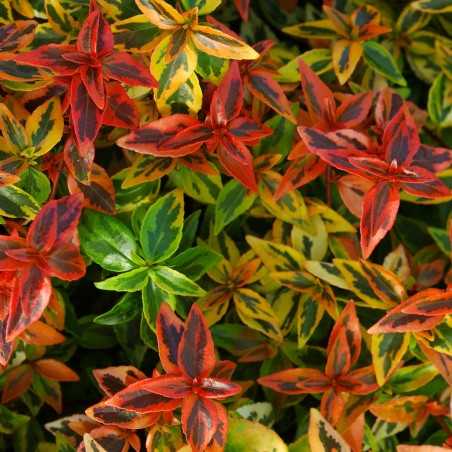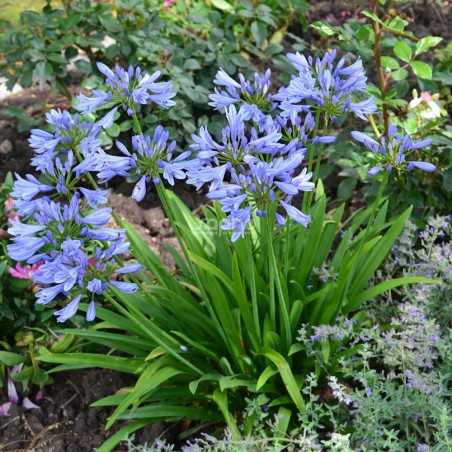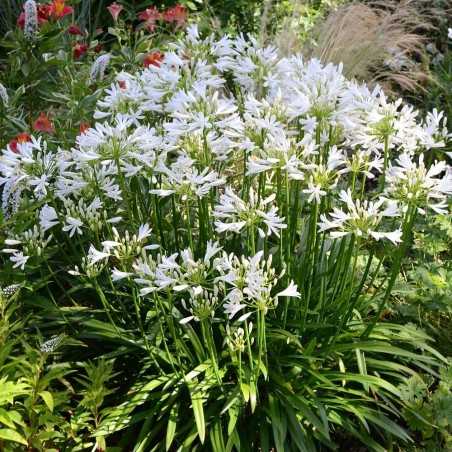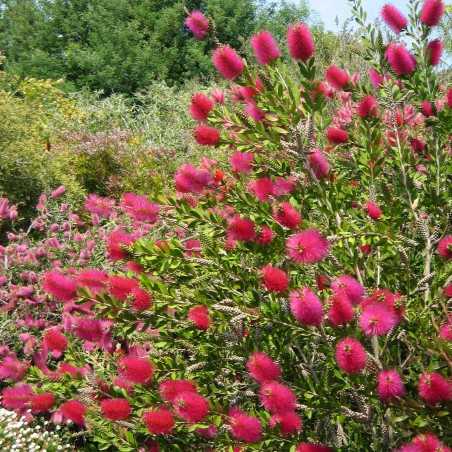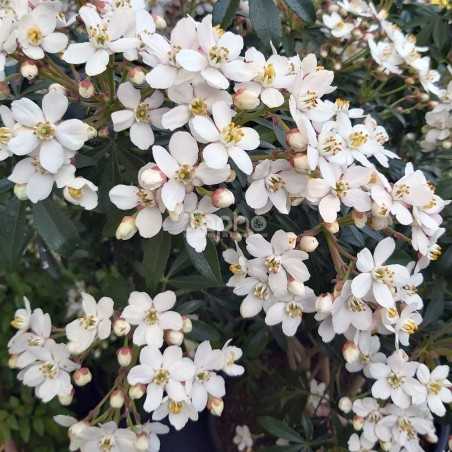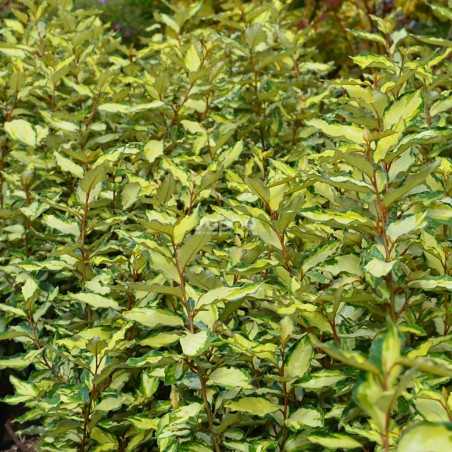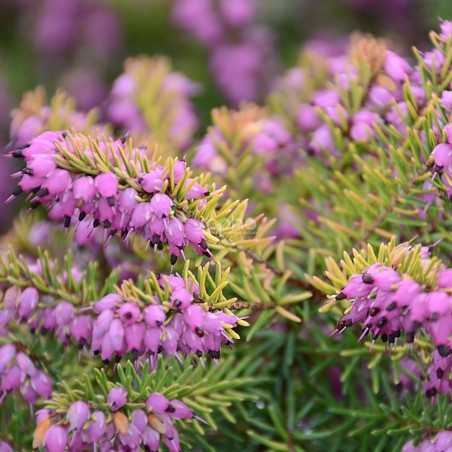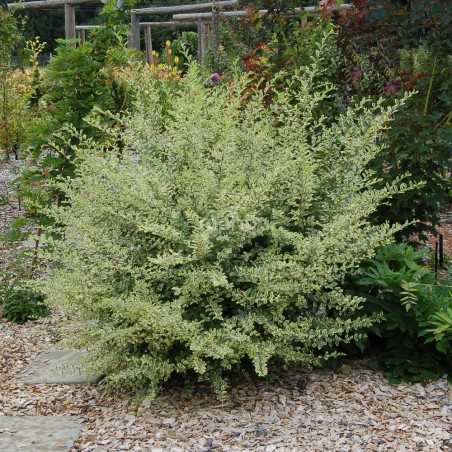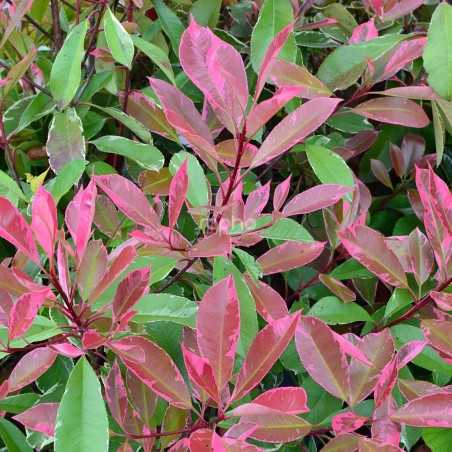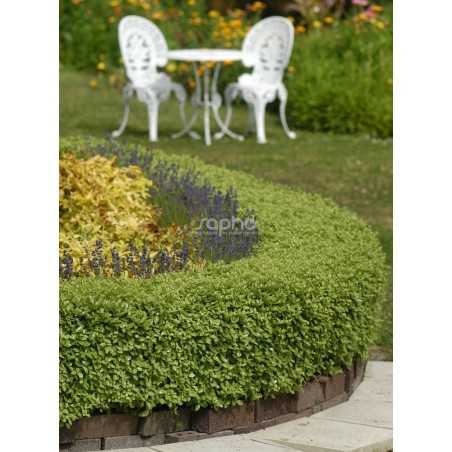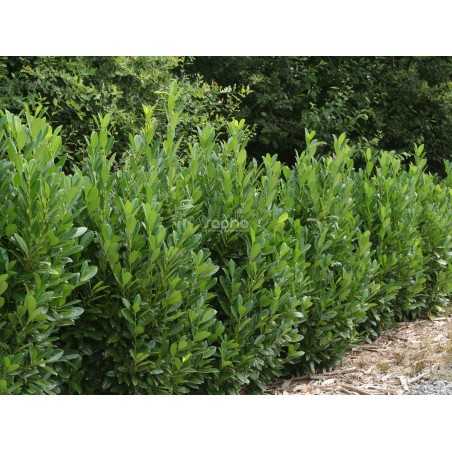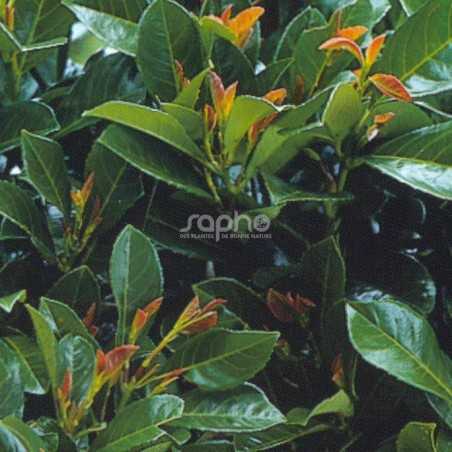A constantly renewed kaleidoscope, much appreciated by gardeners.
This evergreen shrub with variegated foliage, light green and golden yellow in spring, is coming into young orange coloured shoots turning to scarlet red at the end of summer up to winter. These shades can vary according to the position, climate and type of soil.Its growth is dense and even.The lightly fragrant white flowers, from June to September-October, stand in beautiful contrast to the purple stems.Must be protected in regions with cold winters.
Trophies:
Bronze Medal at PLANTARIUM 2006 (Boskoop - NETHERLANDS)
Categories
Menu
Nos stars
PITCHOUNE® Blue, a beautiful blue and compact African lily.
This Agapanthus presents all the qualities of the PITCHOUNE® range. Made up of numerous flowers, these umbels are bigger and of a deeper blue than those of dwarf Agapanthus praecox; they bloom in June - July, their flowering is good.The leaves are wide and evergreen.PITCHOUNE® Blue will have a nice summery effect, planted outside in areas of temperate climate, or in pots.
From the PITCHOUNE® range, a vividly reblooming white agapanthus
This Agapanthus presents all the qualities of the PITCHOUNE® range.The first white very dense umbels open in June-July. It's an exceptional variety due to its renewed flowering until early September, under good conditions.Thanks to its reduced dimensions, its evergreen foliage and long and dense flowering, PITCHOUNE® White is ideal, grown in pots or in the soil in areas of temperate climate.
Bright pink flowers for this Callistemon, more hardy than other classic varieties.Like all the 'bottle brushes', the flowers are grouped in a characteristic way like flower stalks at the end of the branches; the long stamens give the shrub its ornamental appeal.It is scarlet pink, a complimentary colour to the traditional varieties, the flowers bloom from the end of May and in June for a month and more discretely in the autumn if they are cut under the wilted flowers.The red coloured young shoots make room for fine narrow grey-green foliage, which can persist all winter. HOT PINK is hardier than other classic varieties.The shape of this Callistemon selection originating from South Africa is rounded and well ramified and grows up to to 2 meters in height in areas with favourable climate.
A choisya with an unusual robust habit, large and abundant flowers gradually changing from pink to white
GREENFINGERS 'Lissfing' is an outstanding variety with an unusual dense habit and abundant flowers. The plant is well-structured with robust branches; the internodes, shorter than in other Choisya, give it a more compact silhouette, with denser foliage. In spring, its abundant, pleasantly fragrant flowers are particularly striking, combining candy pink buds with pure white open blooms. In good weather conditions, this variety can flower again in autumn. Its evergreen foliage has an attractive dark-green tinge. The flowers of GREENFINGERS 'Lissfing' are larger than those of traditional Choisya varieties. It is a hardy plant that can be grown in sun or part shade. Suitable for all fertile soils, it can reach 2 m x 2 m after five years.
This new variety is a hybrid between Choisya ternata and arizonica. GREENFINGERS 'LISSFING' is a result from the hybridisation work led by Peter Catt from Liss Forest Nursery. It is the newest addition to the range that already includes the outstanding varieties: Choisya SCENTED GEM 'LISSBRID' and Choisya GOLD STAR 'LISSTAR'
An original colour and a very even growth for this new ElaeagnusThe foliage is widely variegated in a light yellow which gets stronger with the seasons. This shrub stands out from far away due to its luminosity. Its good ramification, its compact shape, its evenness, make it an excellent container plant and is easy to use in the garden. Reacting well to pruning, it can be used in a hedge. Like all the other Elaeagnus, the discrete, white and scented flowering takes place in autumn.Trophies: Bronze Medal at PLANTARIUM 2015 (Boskoop - Netherlands)
A precious heather for the garden.
Mutant of the well-known variety 'Kramer's Rote', 'Eva Gold' possesses all its qualities: rapid growth, rounded and compact shape, long-lasting and abundant red flowers in the middle of winter for an Erica type heather.
The colour of its foliage has the particularity of changing throughout the year, from the light green new growth, turning golden yellow in summer, again becoming pure green in winter.
Attractive individually or in large groups, possibly planted with other heathers, 'Eva Gold' will embellish borders and slopes, as much with its remarkable flowers from November to March, as with its bright yellow colour in summer, which does not fade in the sun. It can also be planted in pots.
Trophies:
Praised by the Boskoop observation station (NETHERLANDS)
Luminous shrub, MUSLI® is noticeable from a distance.MUSLI® was discovered and selected as a seedling of Ligustrum ibota in Switzerland.Leaves are opposite, evergreen to semi-evergreen and remarkable for their lasting variegation, highly resistant to the sun. The young shoots are light yellow, turning white with time. The foliage is more or less variegated, light grey-green with creamy white edges, sometimes so wide that they cover the entire width of the leaf.When young, the shrub is of bushy and spreading growth with arching branches. Then MUSLI® forms an even bush with a dense centre. It is of moderate growth.In early summer, the shrub will produce clusters of fragrant white tubular, nectar bearing flowers, turning into blue-black berries, which attract the birds.This shrub tolerates cutting back and is suitable in topiary, in a monospecific or a mixed hedge. Together with other shrubs or in a pot is is very remarkable by its particularoy bright foliage.Trophies: Bronze medal at PLANTARIUM 2011 (Boskoop - NETHERLANDS)
Beautifully mixed colours and an upright and regular formIts variegated foliage brings colour throughout the year. Photinia Louise has also been selected for its vigorous, erect growth and its ample vegetation that's regular, compact and dense. Photinia Louise is a shrub with persistent leaves and changing colours. In spring and autumn the young shoots are bright red spotted with pink.The developing leaves become thick and green, spotted wih creamy white. Its flowers, in May, are quite discreet, forming creamy white umbels. Upkeep is easy as it needs little pruning other than that required by the garden. In a hedge, a mixed bed or as a solitary shrub, 2 to 3 m high, Photinia Louise will enliven a garden throughout the year.
Recommended for its low, naturally ball shaped growthThis cultivar originates from New Zealand.?Golf Ball? has a very round shape, not more than 1 m in dimension. It grows rapidly and stands out by its dense branches from the base upwards.Its evergreen foliage is light green.Discrete violet-brown flowers appear in Mai and June. The have a scent of honey but are of no decorative interest. 'Golf Ball' resists rather well to drought, and to temperatures of -5 to -10° C. It is excellent for the sea side because it accepts mist and wind.Recommended for small areas and low hedges, it is also suitable for pots and as topiary, like box.
A hardy selection with well-branched growth, for a maintenance-free hedge.This variety, coming from a Prunus laurocerasus 'Otto Luyken' seedling, was selected for its rapid growth and its well branched and upright habit, resembling a compact flame.It has few flowers in spring, and therefore only a little fruit afterwards.Rustic evergreen, particularly resistant to disease, not needing pruning, 'Greentorch' is an ideal variety for a monospecific hedge without worries.
Little springtime vulcanos for a low hedge.This variety of laurel with elegant branches naturally reaches a height of about 2 m and a spread of 1.50 m, all the while keeping its compact shape. It is of medium to slow growth.The coppery young shoots are decorative and contrast well with the shiny dark green foliage, which is evergreen.The creamy white flowers in May are followed by deep violet berries.ETNA® tolerates pruning and is recommended for the composition of moderate sized hedges (up to 0.80 m). Mixed with other shrubs, it brings an evergreen touch to beds. It can also be used in containers.Trophies: Gold medal at the Plantarium 1994. (Boskoop - NETHERLANDS)

